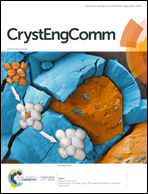Adsorption of anthracene substitutes into suprachannels: bulk vs. included guests†
Abstract
Self-assembly of Ag(I) cations with N,N′,N′′-tris(2-(pyridin-4-yl)ethyl)-1,3,5-benzenetricarboxamide (L) produces new 2D metal–organic networks with 108-membered rings, [Ag3L2]. The 2D networks are interlayer-packed, which results in the formation of hydrophobic suprachannels (19.2 × 27.6 Å). Around each silver(I) ion, triflate counteranions are confined (2.93(1)–3.041(9) Å), thus the hydrophobic suprachannels effectively adsorb a wide range of anthracene substitutes in either a monomeric or an excimeric mode, which makes them potentially useful as energy-transfer materials.



 Please wait while we load your content...
Please wait while we load your content...